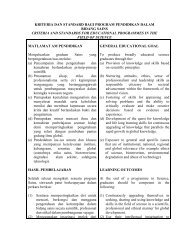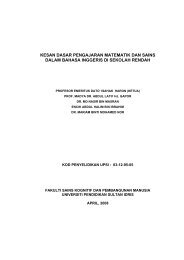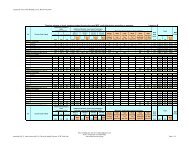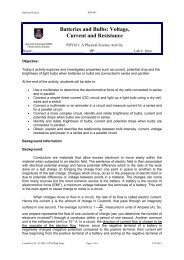Sample problems Chap 19 Cutnell.pdf - DrJJ
Sample problems Chap 19 Cutnell.pdf - DrJJ
Sample problems Chap 19 Cutnell.pdf - DrJJ
You also want an ePaper? Increase the reach of your titles
YUMPU automatically turns print PDFs into web optimized ePapers that Google loves.
<strong>Sample</strong>s of conceptual and analytical/numerical questions from chap<strong>19</strong>, C&J, 7E<br />
<strong>Sample</strong>s of solutions to conceptual <strong>problems</strong> from chapter<br />
<strong>19</strong> <strong>Cutnell</strong> & Johnson 7E<br />
2. A positive point charge and a negative point charge have equal magnitudes. One charge is<br />
fixed to one corner of a square, and the other is fixed to another corner. On which corners<br />
should the charges be placed, so that the same potential exists at the empty corners Give<br />
your reasoning.<br />
2. REASONING AND SOLUTION The potential at a point in space that is a distance r<br />
from a point charge q is given by Equation <strong>19</strong>.6: V = kq/ r. When more than one point<br />
charge is present, the total potential at any location is the algebraic sum of the individual<br />
potentials created by each charge at that location.<br />
A positive point charge and a negative<br />
point charge have equal magnitudes. One<br />
of the charges is fixed to one corner of a<br />
square. If the other charge is placed<br />
opposite to the first charge along the<br />
q = +Q<br />
L<br />
diagonal of the square, then each charge L<br />
L<br />
will be the same distance L from the<br />
empty corners. The potential at each of<br />
the empty corners will be<br />
q = – Q<br />
L<br />
k( + Q) k( −Q)<br />
V = + = 0<br />
L L<br />
Therefore, if the potential at each empty corner is to be the same, then the charges must<br />
be placed at diagonally opposite corners as shown in the figure.<br />
4. What point charges, all having the same magnitude, would you place at the corners of a<br />
square (one charge per corner), so that both the electric field and the electric potential<br />
(assuming a zero reference value at infinity) are zero at the center of the square Account for<br />
the fact that the charge distribution gives rise to both a zero field and a zero potential.<br />
4. REASONING AND SOLUTION Four<br />
point charges of equal magnitude are<br />
placed at the corners of a square as shown<br />
in the figure at the right.<br />
The electric field at the center of the<br />
square is the vector sum of the electric<br />
field at the center due to each of the<br />
charges individually. The potential at the<br />
q q<br />
1<br />
2<br />
center of the square is equal to the algebraic sum of the potentials at the center due to<br />
each of the charges individually.<br />
All four charges are equidistant from the center (a distance r in the figure). If two<br />
diagonal charges have the same magnitude and sign, then the electric field at the center<br />
due to these two charges have equal magnitude and opposite directions. Their resultant<br />
is, therefore, zero. Thus, the electric field at the center will be zero if each diagonal pair<br />
of charges has the same magnitude and sign.<br />
q 4<br />
r<br />
r<br />
r<br />
r<br />
q 3<br />
Compiled by <strong>DrJJ</strong> Page 1 of 9 8/17/2006
<strong>Sample</strong>s of conceptual and analytical/numerical questions from chap<strong>19</strong>, C&J, 7E<br />
If a diagonal pair of charges has the same magnitude and sign, they will give rise to a<br />
non-zero potential at the center. Thus, the potential due to one diagonal pair of charges<br />
must cancel the potential due to the other diagonal pair of charges. This will be the case<br />
if the two pairs of diagonal charges have opposite signs.<br />
Thus, both the electric field and the electric potential will be zero at the center of the<br />
square if all four charges have the same magnitude, q 1<br />
and q 3<br />
have the same sign, and q 2<br />
and q 4<br />
have the same sign, which is opposite to the signs of q 1<br />
and q 3<br />
.<br />
__________________________________________________________________________________________<br />
7. An electric potential energy exists when two protons are separated by a certain distance.<br />
Does the electric potential energy in crease, decrease, or remain the same when (a) both<br />
protons are replaced by electrons, and (b) only one of the protons is replaced by an electron<br />
Justify your answers.<br />
7. REASONING AND SOLUTION An electric potential energy exists when two protons<br />
are separated by a certain distance. It is equal to the work that must be done by an<br />
external agent to assemble the configuration. Suppose that we imagine assembling the<br />
system, one particle at a time. If there are no other charges in the region, there are no<br />
existing electric fields; therefore, no work is required to put the first proton in place.<br />
That proton, however, gives rise to an electric field that fills the region. Its magnitude at<br />
2<br />
a distance r from the proton is given by Equation 18.3, E = ke / r , where +e is the<br />
magnitude of the charge on the proton. Since the region contains an electric field due to<br />
the first proton, there also exists an electric potential, and the external agent must do<br />
work to place the second proton at a distance d from the first proton. The electric<br />
potential energy of the final configuration is equal to the work that must be done to bring<br />
the second proton from infinity and place it at a distance d from the first proton. The<br />
electric potential at a distance d from the first proton is Vproton =+ ke/<br />
d (Equation<br />
<strong>19</strong>.6). According to Equation <strong>19</strong>.3, the electric potential energy of the final<br />
configuration is therefore<br />
ke<br />
EPE = Vproton<br />
( + e)<br />
=+<br />
d<br />
a. If both protons are replaced by electrons, similar arguments apply. However, since<br />
the electron carries a negative charge (–e), the electric potential at a distance d from the<br />
first electron is Velectron =− ke/<br />
d . The electric potential energy of the final configuration<br />
is now given by<br />
2<br />
EPE<br />
electron<br />
( ) ke ke<br />
= V − e =− ( − e)<br />
=+<br />
d d<br />
Therefore, if both protons are replaced by electrons, the electric potential energy remains<br />
the same.<br />
b. When only one of the protons is replaced by an electron, we find that<br />
2<br />
⎛<br />
EPE<br />
proton<br />
( ) ke ⎞ ke<br />
= V − e = ⎜+ ⎟ ( − e)<br />
=−<br />
⎝ d ⎠ d<br />
2<br />
Compiled by <strong>DrJJ</strong> Page 2 of 9 8/17/2006
<strong>Sample</strong>s of conceptual and analytical/numerical questions from chap<strong>19</strong>, C&J, 7E<br />
Thus, when only one of the protons is replaced by an electron, the electric potential<br />
energy decreases from + ke<br />
2 / d to − ke<br />
2 / d .<br />
__________________________________________________________________________________________<br />
16. A proton and an electron are released from rest at the midpoint between the plates of a<br />
charged parallel plate capacitor. Except for these particles, nothing else is between the plates.<br />
Ignore the attraction between the proton and the electron, and decide which particle strikes a<br />
capacitor plate first. Why<br />
16. REASONING AND SOLUTION Since both particles are released from rest, their<br />
initial kinetic energies are zero. They both have electric potential energy by virtue of<br />
their respective positions in the electric field between the plates. Since the particles are<br />
oppositely charged, they move in opposite directions toward opposite plates of the<br />
capacitor. As they move toward the plates, the particles gain kinetic energy and lose<br />
potential energy. Using (EPE) 0<br />
and (EPE) f<br />
to denote the initial and final electric<br />
potential energies of the particle, respectively, we find from energy conservation that<br />
2<br />
( EPE) =<br />
1<br />
m v + ( EPE)<br />
The final speed of each particle is given by<br />
0 2 particle f<br />
f<br />
v<br />
f<br />
=<br />
( ) − ( )<br />
2⎡<br />
⎣<br />
EPE EPE<br />
m<br />
0 f<br />
particle<br />
⎤<br />
⎦<br />
Since both particles travel through the same distance between the plates of the capacitor,<br />
the change in the electric potential energy is the same for both particles. Since the mass<br />
of the electron is smaller than the mass of the proton, the final speed of the electron will<br />
be greater than that of the proton. Therefore, the electron travels faster than the proton as<br />
the particles move toward the respective plates. The electron, therefore, strikes the<br />
capacitor plate first.<br />
__________________________________________________________________________________________<br />
CHAPTER <strong>19</strong> Electric Potential Energy And The<br />
Electric Potential<br />
<strong>Sample</strong>s of solutions to Problems from chapter <strong>19</strong> <strong>Cutnell</strong><br />
& Johnson 7E<br />
4. A particle has a charge of and moves from point A to point B, a distance of 0.20 m.<br />
The particle experiences a constant electric force, and its motion is along the line of action of<br />
the force. The difference between the particle’s electric potential energy at A and B is<br />
. (a) Find the magnitude and direction of the electric force<br />
that acts on the particle. (b) Find the magnitude and direction of the electric field that the<br />
particle experiences.<br />
Compiled by <strong>DrJJ</strong> Page 3 of 9 8/17/2006
<strong>Sample</strong>s of conceptual and analytical/numerical questions from chap<strong>19</strong>, C&J, 7E<br />
4. REASONING Equation <strong>19</strong>.1 indicates that the work done by the electric force as the<br />
particle moves from point A to point B is W AB<br />
= EPE A<br />
– EPE B<br />
. For motion through a<br />
distance s along the line of action of a constant force of magnitude F, the work is given<br />
by Equation 6.1 as either +Fs (if the force and the displacement have the same direction)<br />
or –Fs (if the force and the displacement have opposite directions). Here, EPE A<br />
– EPE B<br />
is given to be positive, so we can conclude that the work is W AB<br />
= +Fs and that the force<br />
points in the direction of the motion from point A to point B. The electric field is given<br />
by Equation 18.2 as E = F/q 0<br />
, where q 0<br />
is the charge.<br />
SOLUTION a. Using Equation <strong>19</strong>.1 and the fact that W AB<br />
= +Fs, we find<br />
W<br />
=+ Fs = EPE −EPE<br />
AB A B<br />
−4<br />
EPE<br />
A− EPEB<br />
9.0×<br />
10 J<br />
−3<br />
F = = = 4.5×<br />
10 N<br />
s 0.20 m<br />
As discussed in the reasoning, the direction of the force is from A toward B .<br />
b. From Equation 18.2, we find that the electric field has a magnitude of<br />
−3<br />
F 4.5×<br />
10 N<br />
3<br />
E = = = 3.0×<br />
10 N/C<br />
q<br />
−6<br />
1.5×<br />
10 C<br />
0<br />
The direction is the same as that of the force on the positive charge, namely<br />
from A toward B .<br />
___________________________________________________________________________<br />
9. The potential at location A is 452 V. A positively charged particle is released there from<br />
rest and arrives at location B with a speed v B . The potential at location C is 791 V, and when<br />
released from rest from this spot, the particle arrives at B with twice the speed it previously<br />
had, or 2v B . Find the potential at B<br />
9. REASONING The only force acting on the moving charge is the conservative electric<br />
force. Therefore, the total energy of the charge remains constant. Applying the principle<br />
of conservation of energy between locations A and B, we obtain<br />
1 2 1 2<br />
mvA + EPE<br />
2 A<br />
= mv<br />
2 B<br />
+ EPEB<br />
Since the charged particle starts from rest, v A<br />
= 0 . The difference in potential energies<br />
is related to the difference in potentials by Equation <strong>19</strong>.4, EPEB− EPE<br />
A<br />
= qV (<br />
B<br />
− VA)<br />
.<br />
Thus, we have<br />
1 2<br />
qV ( − V ) = mv<br />
(1)<br />
A B 2 B<br />
Similarly, applying the conservation of energy between locations C and B gives<br />
Compiled by <strong>DrJJ</strong> Page 4 of 9 8/17/2006
<strong>Sample</strong>s of conceptual and analytical/numerical questions from chap<strong>19</strong>, C&J, 7E<br />
1<br />
C B 2 B<br />
Dividing Equation (1) by Equation (2) yields<br />
VA<br />
– VB<br />
1<br />
VC<br />
– V =<br />
B<br />
4<br />
This expression can be solved for V<br />
B<br />
.<br />
2<br />
qV ( − V ) = m (2 v )<br />
(2)<br />
SOLUTION Solving for V<br />
B<br />
, we find that<br />
4 VA<br />
– VC<br />
4(452 V)–791 V<br />
V<br />
B<br />
= = = 339 V<br />
3 3<br />
___________________________________________________________________________<br />
11. Two charges A and B are fixed in place, at different distances from a certain spot. At this<br />
spot the potentials due to the two charges are equal. Charge A is 0.18 m from the spot, while<br />
charge B is 0.43 m from it. Find the ratio q B /q A of the charges.<br />
11. REASONING The potential of each charge q at a distance r away is given by Equation<br />
<strong>19</strong>.6 as V = kq/r. By applying this expression to each charge, we will be able to find the<br />
desired ratio, because the distances are given for each charge.<br />
SOLUTION According to Equation <strong>19</strong>.6, the potentials of each charge are<br />
V<br />
A<br />
kqA<br />
kq<br />
= and VB<br />
=<br />
r<br />
r<br />
A<br />
B<br />
B<br />
Since we know that V A<br />
= V B<br />
, it follows that<br />
kqA kqB qB rB<br />
0.43 m<br />
= or = = = 2.4<br />
rA rB qA rA<br />
0.18 m<br />
___________________________________________________________________________<br />
16. The drawing shows six point charges arranged in a rectangle. The value of q is ,<br />
and the distance d is 0.13 m. Find the total electric potential at location P, which is at the<br />
center of the rectangle.<br />
Compiled by <strong>DrJJ</strong> Page 5 of 9 8/17/2006
<strong>Sample</strong>s of conceptual and analytical/numerical questions from chap<strong>19</strong>, C&J, 7E<br />
16. REASONING The electric potential at a distance r from a point charge q is given by<br />
Equation <strong>19</strong>.6 as V = kq/<br />
r. The total electric potential at location P due to the six point<br />
charges is the algebraic sum of the individual potentials.<br />
+7.0q +3.0q +5.0q<br />
d<br />
d<br />
d<br />
d<br />
P<br />
d<br />
d<br />
−5.0q −3.0q +7.0q<br />
SOLUTION Starting at the upper left corner of the rectangle, we proceed clockwise<br />
and add up the six contributions to the total electric potential at P (see the drawing):<br />
V<br />
( + 7.0 ) ( + 3.0 ) ( + 5.0 ) ( + 7.0 ) ( −3.0 ) ( −5.0<br />
)<br />
k q k q k q k q k q k q<br />
= + + + + +<br />
d<br />
d<br />
d + ⎜ ⎟ 2 d + ⎜ ⎟ d + ⎜ ⎟ 2 d + ⎜ ⎟<br />
⎝ 2⎠ ⎝ 2⎠ ⎝ 2⎠ ⎝ 2⎠<br />
=<br />
k<br />
2 2 2 2<br />
2 ⎛d ⎞ 2 ⎛d ⎞ 2 ⎛d ⎞ 2 ⎛d<br />
⎞<br />
( + 14.0q)<br />
d<br />
2<br />
⎛d<br />
⎞<br />
+ ⎜ ⎟<br />
⎝ 2 ⎠<br />
2<br />
Substituting q = 9.0 × 10 −6 C and d = 0.13 m gives<br />
⎛<br />
2<br />
9 N⋅<br />
m ⎞<br />
6<br />
⎜8.99× 10<br />
2 ⎟ + 14.0 9.0×<br />
10 C<br />
k( + 14.0q)<br />
C<br />
6<br />
V = =<br />
⎝ ⎠<br />
= + 7.8×<br />
10 V<br />
2 2<br />
2 ⎛d<br />
⎞ 2 ⎛0.13 m ⎞<br />
d + ⎜ ⎟ ( 0.13 m)<br />
+ ⎜ ⎟<br />
⎝ 2⎠ ⎝ 2 ⎠<br />
___________________________________________________________________________<br />
−<br />
( )( )<br />
37. The membrane that surrounds a certain type of living cell has a surface area of<br />
and a thickness of<br />
. Assume that the membrane behaves like a<br />
parallel plate capacitor and has a dielectric constant of 5.0. (a) The potential on the outer<br />
surface of the membrane is +60.0 mV greater than that on the inside surface. How much<br />
charge resides on the outer surface (b) If the charge in part (a) is due to K + ions (charge +e),<br />
how many such ions are present on the outer surface<br />
37. SSM REASONING The charge that resides on the outer surface of the cell<br />
membrane is q = CV , according to Equation <strong>19</strong>.8. Before we can use this expression,<br />
however, we must first determine the capacitance of the membrane. If we assume that<br />
the cell membrane behaves like a parallel plate capacitor filled with a dielectric,<br />
Equation <strong>19</strong>.10 (C =κ ε 0<br />
A / d ) applies as well.<br />
SOLUTION The capacitance of the cell membrane is<br />
Compiled by <strong>DrJJ</strong> Page 6 of 9 8/17/2006
<strong>Sample</strong>s of conceptual and analytical/numerical questions from chap<strong>19</strong>, C&J, 7E<br />
–12 –9 2<br />
κε<br />
0A<br />
(5.0)(8.85× 10 F/m)(5.0×<br />
10 m )<br />
–11<br />
C = = = 2.2×<br />
10 F<br />
d<br />
–8<br />
1.0×<br />
10 m<br />
a. The charge on the outer surface of the membrane is, therefore,<br />
–11 –3 –12<br />
q = CV = (2.2× 10 F)(60.0× 10 V)= 1.3×<br />
10 C<br />
+<br />
b. If the charge in part (a) is due to K ions with charge +e (e = 1.6 × 10 −<strong>19</strong> C), the<br />
number of ions present on the outer surface of the membrane is<br />
Number of 1.3×<br />
10 C<br />
6<br />
+ = = 8.1×<br />
10<br />
K ions −<strong>19</strong><br />
1.6×<br />
10 C<br />
___________________________________________________________________________<br />
42. Two capacitors are identical, except that one is empty and the other is filled with a<br />
dielectric (k = 4.50). The empty capacitor is connected to a 12.0-V battery. What must be the<br />
potential difference across the plates of the capacitor filled with a dielectric such that it stores<br />
the same amount of electrical energy as the empty capacitor<br />
42. REASONING The energy used to charge up a capacitor is stored in the capacitor as<br />
electrical energy. The energy stored depends on the capacitance C of the capacitor and<br />
2<br />
the potential difference V between its plates; Energy = CV (Equation <strong>19</strong>.11b).<br />
Inserting a dielectric between the plates of a capacitor increases its capacitance by a<br />
factor of κ, where κ is the dielectric constant of the material. We will use these two<br />
pieces of information to find the potential difference across the plates of the capacitor<br />
filled with the dielectric.<br />
SOLUTION The energy stored in the empty capacitor is Energy = CV<br />
2 0 0<br />
, where C 0<br />
is<br />
its capacitance and V 0<br />
is the potential difference between its plates. Similarly, the energy<br />
2<br />
stored in the capacitor filled with the dielectric is Energy = CV , where C is its<br />
capacitance and V is the potential difference between its plates. Since the two energies<br />
are equal,<br />
−12<br />
1 2 1 2<br />
CV<br />
2 0 0<br />
= CV<br />
2<br />
Since C = κC 0<br />
(see Equation <strong>19</strong>.10 and the discussion that follows), we have<br />
( κ )<br />
1 2 1 2<br />
2 CV 0 0<br />
=<br />
2<br />
C 0<br />
V<br />
Solving for the potential difference V, gives<br />
V0 12.0 V<br />
V = = = 5.66 V<br />
κ 4.50<br />
1<br />
2<br />
1<br />
2<br />
1<br />
2<br />
Compiled by <strong>DrJJ</strong> Page 7 of 9 8/17/2006
<strong>Sample</strong>s of conceptual and analytical/numerical questions from chap<strong>19</strong>, C&J, 7E<br />
___________________________________________________________________________<br />
59. The potential difference between the plates of a capacitor is 175 V. Midway between the<br />
plates, a proton and an electron are released. The electron is released from rest. The proton is<br />
projected perpendicularly toward the negative plate with an initial speed. The proton strikes<br />
the negative plate at the same instant that the electron strikes the positive plate. Ignore the<br />
attraction between the two particles, and find the initial speed of the proton.<br />
59. REASONING If we assume that the motion of the proton and the electron is horizontal<br />
in the +x direction, the motion of the proton is determined by Equation 2.8,<br />
x 1 2<br />
= vt 0<br />
+ at p<br />
, where x is the distance traveled by the proton, v<br />
0<br />
is its initial speed, and<br />
p<br />
2<br />
a is its acceleration. If the distance between the capacitor places is d, then this relation<br />
becomes<br />
1 1<br />
2 0 2 p<br />
d = v t + a t , or<br />
2<br />
0 p<br />
2<br />
d = 2v t+ a t<br />
(1)<br />
We can solve Equation (1) for the initial speed v 0<br />
of the proton, but, first, we must<br />
determine the time t and the acceleration a<br />
p<br />
of the proton . Since the proton strikes the<br />
negative plate at the same instant the electron strikes the positive plate, we can use the<br />
motion of the electron to determine the time t.<br />
For the electron,<br />
1 1<br />
2<br />
d 2 e<br />
2<br />
= a t , where we have taken into account the fact that the electron<br />
is released from rest. Solving this expression for t we have t = d/<br />
ae<br />
. Substituting<br />
this expression into Equation (1), we have<br />
d ⎛ap<br />
⎞<br />
d = 2 v0<br />
+⎜ d<br />
a ⎜<br />
e<br />
a ⎟<br />
⎝ e ⎠<br />
(2)<br />
The accelerations can be found by noting that the magnitudes of the forces on the<br />
electron and proton are equal, since these particles have the same magnitude of charge.<br />
The force on the electron is F = eE = eV / d , and the acceleration of the electron is,<br />
therefore,<br />
Newton's second law requires that ma<br />
e e<br />
= ma<br />
p p, so that<br />
a<br />
e<br />
= F eV<br />
m<br />
= m d<br />
(3)<br />
a<br />
a<br />
p<br />
e<br />
e<br />
p<br />
e<br />
me<br />
= (4)<br />
m<br />
Combining Equations (2), (3) and (4) leads to the following expression for v 0<br />
, the initial<br />
speed of the proton:<br />
Compiled by <strong>DrJJ</strong> Page 8 of 9 8/17/2006
<strong>Sample</strong>s of conceptual and analytical/numerical questions from chap<strong>19</strong>, C&J, 7E<br />
v<br />
0<br />
=<br />
1 ⎛ m<br />
1–<br />
2 ⎜ m<br />
⎝<br />
e<br />
p<br />
⎞<br />
⎟<br />
⎠<br />
eV<br />
m<br />
e<br />
SOLUTION Substituting values into the expression above, we find<br />
–31 –<strong>19</strong><br />
1 ⎛ 9.11× 10 kg ⎞ (1.60×<br />
10 C)(175 V)<br />
6<br />
v0 = 1– 2.77 10 m/s<br />
2 ⎜<br />
–27 = ×<br />
–31<br />
1.67 10 kg ⎟<br />
⎝ × ⎠ 9.11×<br />
10 kg<br />
___________________________________________________________________________<br />
Compiled by <strong>DrJJ</strong> Page 9 of 9 8/17/2006

















